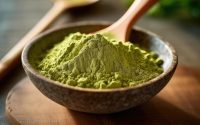Kratom and Fitness: Enhancing Workouts Naturally
In the realm of fitness and wellness, individuals constantly seek natural supplements to enhance their performance, endurance, and recovery. Kratom, a plant native to Southeast Asia, has garnered attention for its potential benefits in various aspects of health, including fitness. With anecdotal reports suggesting improved focus, energy, and pain management, many fitness enthusiasts are exploring the role of kratom in their workout routines. In this blog, we delve into the relationship between kratom and fitness, exploring its potential benefits, safety considerations, and practical applications for enhancing workouts naturally.
Understanding Kratom
Kratom, scientifically known as Mitragyna speciosa, is a tropical tree indigenous to regions like Thailand, Malaysia, Indonesia, and Papua New Guinea. You can also buy kratom powder online for convenient access to this natural supplement. Traditionally, its leaves have been used for their stimulant and analgesic properties, often brewed into teas or chewed for energy and pain relief. Kratom contains active compounds such as mitragynine and 7-hydroxymitragynine, which interact with opioid receptors in the brain, producing various effects including pain relief, mood enhancement, and stimulation.
Benefits of Kratom in Fitness

Increased Energy and Focus
One of the primary reasons individuals incorporate kratom into their fitness regimen is for its energizing effects. Kratom’s stimulating properties can provide a natural boost in energy levels, making it easier to tackle intense workouts with focus and determination. Whether you’re hitting the gym for weightlifting or engaging in high-intensity interval training (HIIT), kratom may help elevate your performance by combating fatigue and enhancing mental clarity.
Enhanced Endurance
Endurance is crucial for sustaining prolonged physical activity, whether it’s running, cycling, or endurance training. Some users report that kratom helps improve endurance by reducing perceived exertion and increasing tolerance to discomfort. By potentially modulating pain perception and promoting a sense of well-being, kratom may enable individuals to push through barriers and extend their workout durations, ultimately leading to greater fitness gains over time.
Pain Management
Exercise-induced muscle soreness and discomfort are common challenges faced by fitness enthusiasts, especially during intense training phases. Kratom’s analgesic properties may offer relief from post-workout soreness and inflammation, allowing for quicker recovery and reduced downtime between training sessions. Moreover, by alleviating discomfort, kratom may encourage individuals to maintain consistency in their workout routines, leading to better long-term results.
Mood Enhancement and Motivation
Maintaining motivation and a positive mindset are vital for achieving fitness goals. Kratom’s potential to uplift mood and enhance motivation can be advantageous, particularly on days when motivation is lacking or when overcoming mental barriers to exercise. By promoting feelings of well-being and enthusiasm, kratom may help individuals approach their workouts with greater enthusiasm and dedication, fostering a more rewarding fitness journey overall.
Safety Considerations
While kratom holds promise as a natural aid for fitness enthusiasts, it’s essential to approach its use with caution and awareness of potential risks. Here are some key safety considerations to keep in mind:
Dosage: Proper dosage is crucial when using kratom, as excessive consumption can lead to adverse effects such as nausea, dizziness, and even respiratory depression. Start with a low dose and gradually increase as needed, paying attention to individual tolerance levels and sensitivity.
Quality and Purity: Ensure that you source kratom from reputable vendors who provide high-quality, lab-tested products. Contaminants or adulterants in kratom products can pose significant health risks, so prioritize purity and transparency when making purchases.
Dependency and Withdrawal: Kratom contains alkaloids that interact with opioid receptors, potentially leading to dependence and withdrawal symptoms with prolonged use. To mitigate the risk of dependence, use kratom responsibly and avoid excessive or frequent consumption.
Interaction with Medications: Kratom may interact with certain medications, including antidepressants, opioids, and stimulants. If you’re taking any prescription medications, consult with a healthcare professional before incorporating kratom into your fitness routine to avoid potential adverse reactions.
Practical Applications

Integrating kratom into your fitness regimen requires thoughtful consideration and responsible usage. Here are some practical tips for incorporating kratom into your workouts effectively:
Experiment with Different Strains: Kratom comes in various strains, each with unique properties and effects. Experiment with different strains such as White Vein for energy and focus, Green Vein for a balanced experience, or Red Vein for relaxation and pain relief, to find the one that best compliments your fitness goals and preferences.
Timing and Dosage: Timing your kratom intake is essential for maximizing its benefits during workouts. Consider consuming kratom approximately 30-45 minutes before your exercise session to allow time for absorption and onset of effects. Start with a low to moderate dosage, typically 1-3 grams, and adjust as needed based on your response.
Stay Hydrated: Like any stimulant, kratom can potentially cause dehydration, especially during intense physical activity. Ensure you stay adequately hydrated before, during, and after your workouts by drinking plenty of water to prevent adverse effects and promote overall well-being.
Listen to Your Body: Pay attention to how your body responds to kratom during workouts and adjust your usage accordingly. If you experience any discomfort or negative side effects, discontinue use and reassess your approach. Remember that everyone’s body chemistry is unique, so what works for others may not necessarily work for you.
Conclusion
Kratom holds promise as a natural supplement for enhancing workouts, offering potential benefits such as increased energy, endurance, pain management, and mood enhancement. However, its use in fitness should be approached with caution, considering safety considerations such as dosage, quality, dependency risks, and potential interactions with medications. By integrating kratom responsibly and mindfully into your fitness routine, you may discover a valuable ally in your pursuit of health, wellness, and peak performance. As with any supplement, prioritize informed decision-making, listen to your body, and consult with healthcare professionals as needed to optimize your fitness journey safely and effectively.

